|
|
|
[
] [
]
2005 [
] [
] [
] [
]
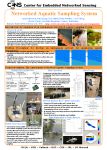
|
2005 ANNUAL RESEARCH REVIEW Poster Session (Oct, 2005)
Networked Aquatic Sampling System,
Amit Dhariwal, Bin Zhang, Eric Shieh, Gaurav S. Sukhatme, Aristides A. Requicha, David Caron, Carl Oberg, Beth Stauffer
There is a need to provide a platform for better monitoring and sampling in Marine environments. Such a platform should be able
to withstand the highly dynamic nature of such an environment as well as cope with its vastness. The platform should be simple and easily scalable. A platform of this type would provide the scientists an invaluable tool in order to
further the marine research by monitoring phenomena of biological importance. As part of our research, we are building a fleet of autonomous roboducks (robotic air boats) for in-situ operation (data collection and analysis: using
the stargate platform) in marine environments. The platform would support a variety of sensor suites and at the same time be easy to operate. It can operate in both exploration mode and intelligent mode. It can also collaborate
(via communication) with other entities (sensor nodes, again using the stargate platform) in the local neighborhood making intelligent decisions. The roboduck fleet in conjunction with the buoy network will serve as a test bed for
evaluating algorithms including bacterial navigation for marine sensing and adaptive sampling.
|
|
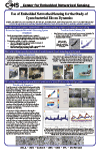
|
2005 ANNUAL RESEARCH REVIEW Poster Session (Oct, 2005)
Use of Embedded Networked Sensing for the Study of Cyanobacterial Bloom Dynamics,
Beth A. Stauffer, Gaurav S. Sukhatme, Bin Zhang, Amit Dhariwal, Carl Oberg, David A. Caron, Aristides Requicha
Developing predictive models for aquatic microbial populations requires very fine spatial and temporal resolution of data that
traditional monitoring techniques are typically incapable of providing. The need for continuous presence in an environment combined with the desire for directed (intelligent) sampling has prompted the development of a sensor
network to address these needs. The network incorporates low-energy demand, and highly adaptable sensors which exploit recent advances in computer networking and robotics to process sensor data and ensure high data fidelity. The
coordination of stationary sensor nodes and mobile sensing using a sampling robot allow for efficient collection of samples from features of interest, exemplified in studies of a recent cyanobacterial bloom in Lake Fulmor,
California.
|
|
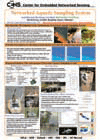
|
2005 NSF SITE VISIT Poster Session (Jun, 2005)
Networked Aquatic Sampling System,
Amit Dhariwal, Bin Zhang, Eric Shieh, Beth Stauffer, Carl Oberg, David Caron, Aristides Requicha, Gaurav Sukhatme
There is a need to provide a platform for better monitoring and sampling in Marine environments. Such a platform should be able to withstand the highly dynamic nature of such an environment as well as cope with its vastness. The
platform should be simple and easily scalable. A platform of this type would provide the scientists an invaluable tool in order to further the marine research by monitoring phenomena of biological importance. As part of our
research, we are building a fleet of autonomous roboducks (robotic air boats) for in-situ operation (data collection and analysis: using the stargate platform) in marine environments. The platform would support a variety of sensor
suites and at the same time be easy to operate.
|
|
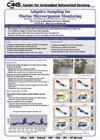
|
2005 NSF SITE VISIT Poster Session (Jun, 2005)
Adaptive Sampling for Marine Microorganism Monitoring,
Bin Zhang, Amit Dhariwal, Eric Shieh, Beth Stauffer, Carl Oberg, Dave Caron, Ari Requicha, and Gaurav Sukhatme
The goal of adaptive sampling is to acquire high-resolution data in the important regions with relative less sensor nodes. We built a system to study the behavior of algae. The system consists of both static sensor nodes and
mobile sensor nodes. The sensors equipped include thermistors and fluorometers. Thermistors measure one of key environment parameters for the growth of the algae while the fluorescence of chlorophyll provides useful pro xy for
algal abundance. The system has been deployed in Lake Fulmor in James Reserve and the data collected in field are presented.
|
|
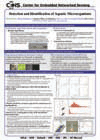
|
2005 NSF SITE VISIT Poster Session (Jun, 2005)
Detection and Identification of Aquatic Microorganisms,
Beth Stauffer, Mrinal Mahapatro, Chongwu Zhou, Ari Requicha, Alex Lee, Chao Li, Stefanie Moorthi, Dave Caron
With an increase in blooms of harmful algae on both national and global levels, it is becoming ever more important to be able to detect these organisms at high spatial and temporal resolutions. It is also imperative that methods of
detection are able to identify target cells at low concentrations. To this end we present a number of immunologically-based techniques for detecting cells of Aureococcus anophagefferens, the cause of .Brown Tides. off the
Mid-Atlantic coast. These techniques include flow cytometry, atomic force microscopy, and nanowire- and nanotube-based sensing. We also detail experiments carried out in a laboratory testbed demonstrating ecologically significant
behavior patterns in two harmful algal species responsible for .Brown. and .Red. tides on the east and west coast, respectively.
|
|
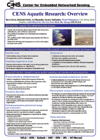
|
2005 NSF SITE VISIT Poster Session (Jun, 2005)
CENS Aquatic Research: Overview,
Dave Caron, Deborah Estrin, Ari Requicha, Gaurav Sukhatme; Mrinal Mahapatro, Carl Oberg, Beth Stauffer; Amit Dhariwal, Alex Lee, Eric Shieh, Bin Zhang; USC/UCLA
|
|
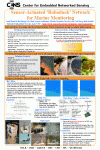
|
Stargate Developer's Forum Poster Session (May, 2005)
Sensor-Actuated 'Roboduck' Network for Marine Monitoring,
Amit Dhariwal, Gaurav S. Sukhatme, Aristides A. Requicha, David Caron, Carl Oberg, Beth Stauffer, Eric Shieh
There is a need to provide a platform for better monitoring and sampling in Marine environments. Such a platform should be able to withstand the highly dynamic nature of such an environment as well as cope with its vastness. The
platform should be simple and easily scalable. A platform of this type would provide the scientists an invaluable tool in order to further the marine research by monitoring phenomena of biological importance.
As part of our research, we are building a fleet of autonomous roboducks (robotic air boats) for in-situ operation (data collection and analysis: using the stargate platform) in marine environments. The platform would support a
variety of sensor suites and at the same time be easy to operate. It can operate in both exploration mode and intelligent mode. It can also collaborate (via communication) with other entities (sensor nodes, again using the stargate
platform) in the local neighborhood making intelligent decisions. The roboduck fleet in conjunction with the buoy network will serve as a test bed for evaluating algorithms including bacterial navigation for marine sensing and
adaptive sampling.
Some of the results we have obtained so far include autonomous GPS way point navigation and autonomous data collection of temperature and flourometry data over a day in marine environment.
|
|
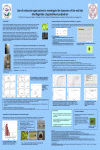
|
ASLO Aquatic Sciences Meeting Poster Session, Salt Lake City, Utah. (Feb, 2005)
Use of molecular approaches to investigate the dynamics of the red tide dinoflagellate Lingulodinium polyedrum,
Stefanie Moorthi, Peter Countway, Astrid Schnetzer, David Caron.
|
|
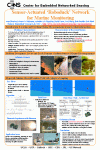
|
EAB Poster Session (Jan, 2005)
Sensor-Actuated 'Roboduck' Network for Marine Monitoring,
Amit Dhariwal, Gaurav S. Sukhatme, Aristides A. Requicha, David Caron, Carl Oberg, Beth Stauffer, Eric Shieh
|
|
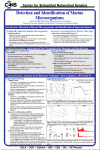
|
EAB Poster Session (Jan, 2005)
Detection and Identification of Marine Microorganisms,
Beth A. Stauffer, David Caron, Mrinal Mahapatro, Ari Requicha.
|
|
|
|
|
The material presented here is based upon work supported by the
National Science Foundation under Grant No. CCF-0120778. Any
opinions, findings, and conclusions or recommendations expressed
in this material are those of the author(s) and do not necessarily
reflect the views of the National Science Foundation.
|
|







